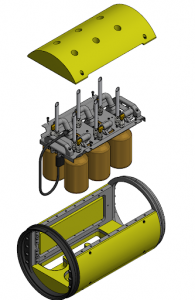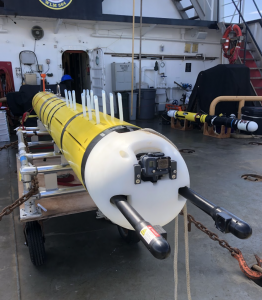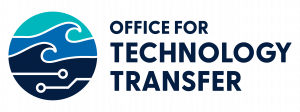WHOI Engineers Invent Sampling System for AUVs used in Oil Spill Response
The oil that enters aquatic environments can have significant ecosystem impacts. Most spilled oil from platforms and vessels floats on the water surface, but spills under the water can be more challenging to detect and observe. Underwater oil spills require additional observation measurements from remote sensors, surface vessels, and remotely operated and autonomous vehicles, which cannot identify oil in the midwater. These Water samples are then required to undergo further laboratory analysis to determine the hydrocarbon classes and concentration - revealing crucial information for

Sampling bottles are placed in an aluminum frame which is attached to the host AUV (Rendering courtesy of Amy Kukulya)
understanding the extent and effects of the spilled oil.
To protect and preserve water samples for analysis and overcome the obstacles of sampling oil underwater and under ice, Woods Hole Oceanographic Institution (WHOI) Research Engineer Amy Kukulya, Senior Engineer Daniel Gomez-Ibanez, and their team developed the Midwater Oil Sampler. The Sampler is a vehicle-agnostic water sampling system designed to minimize contamination and enable autonomous and expedited detection and sampling in precise underwater locations. The modular system is configured with several glass sampling bottles from EPA-certified vendors. Several midwater oil sampler systems can be pigtailed in parallel. Although the Sampler was designed for sampling oil, it can be used as a water sampler for several contaminants or in situ water measurements.
‘Our approach to build tools that people not only want to use but to build them in a system agnostic way that can help society, as a whole, understand contaminants in our waterways led us to create the modular midwater oil sampler. We hope it helps not just the oil spill community, but scientists, broadly, study ocean carbon effects, harmful algal blooms, and microplastics, to name a few.’ Amy Kukulya

The Midwater Oil Sampler integrated into a REMUS AUV (photo courtesy of Amy Kukulya)
In August 2019, the team successfully deployed the Midwater Oil Sampler integrated into a REMUS 600 AUV to capture target water samples in natural oil seeps off Santa Barbara, California. In their recently published paper Autonomous Water Sampler for Oil Spill Response, the team describes the capabilities of the Midwater Oil Sampler.
During the mission, the vehicle and Sampler employ user-defined Adaptive Sampling techniques known as mission objectives. The objective allows triggering criteria for water sampling. When the anomaly is detected independently from criteria for previous survey passes, such as a spike in dissolved hydrocarbons, water is collected into a bottle and preserved for laboratory analysis. By following Adaptive Sampling objectives, the vehicle can obtain additional underwater observations and water samples once the triggering criteria for the water samples are met before returning to the designated survey grid.
“Even a large oil spill spreads out and becomes diluted in the ocean. The Midwater Oil Sampler uses impervious materials to collect and preserve water samples so that even faint traces of oil can be measured precisely,” says Gomez-Ibanez.
The Midwater Oil Sampler is currently covered by a pending patent application. To learn more about licensing opportunities, please contact Allison Markova, Assistant Director Technology Transfer, amarkova@whoi.edu.
Learn more:
Autonomous Water Sampling for Oil Spill Response


